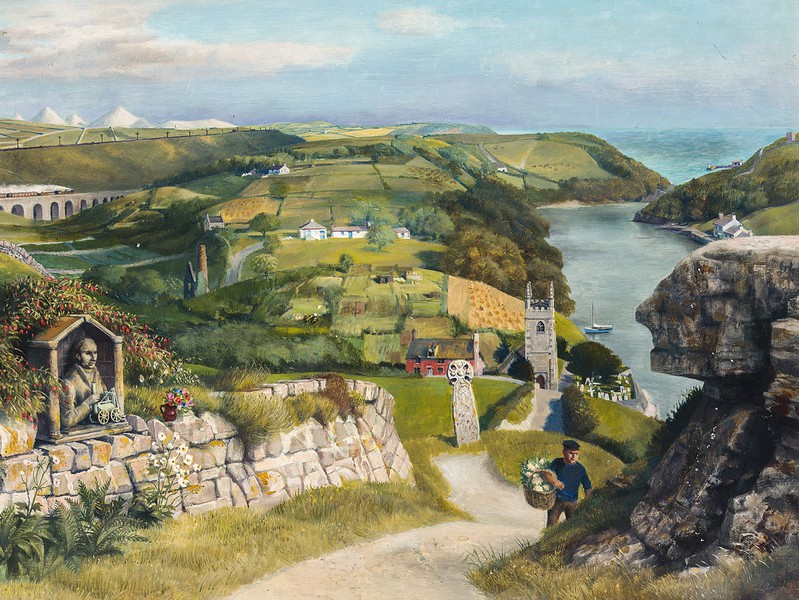

1958
Oil on board
33 x 42 cm
Whereabouts unknown
Birds Eye View Shell and Post Office Commissions Narrative Works | 1950 to 1959 Landscapes | Gardens Bonfires | Flames | Smoke Commissioned Works
Recto: Signed and dated lower left: R.Eurich 58'
Verso: Signed on backboard "Cornwall, Richard Eurich"; Shell-Mex collection label; Arts Council label from unknown exhibition
Other measurements: 36x41cm [Bonhams]
Cornwall England architecture basket building cap churches clay fields figure figures in a landscape hat hedges inlet landscape man river sea stone wall topographical view train viaduct wheat sheafs wheat stacksThis painting was one of six commissioned from Richard by Shell-Mex and B.P. Ltd. to use as illustrations in their guides and calendars. See images below.
A rough triangle in the sea describes Cornwall, which is tilted from north to south so that the south coast is pierced by “ pills ”, which are sunken (and now tidal) river valleys. Oak-woods (1) often grow along them, originally planted to provide charcoal for smelting and oak-bark for tanneries, and churches crouch in their shelter, dedicated to Celtic saints, each with a square, buttressed tower of the fifteenth century (2). Headlands jut to sea, hills are cut by hedges of earth and stone into small ancient fields. Sycamores surround squat farmstends (3). Wheel-headed wayside crosses (4) of moor‐ …
A rough triangle in the sea describes Cornwall, which is tilted from north to south so that the south coast is pierced by “ pills ”, which are sunken (and now tidal) river valleys. Oak-woods (1) often grow along them, originally planted to provide charcoal for smelting and oak-bark for tanneries, and churches crouch in their shelter, dedicated to Celtic saints, each with a square, buttressed tower of the fifteenth century (2). Headlands jut to sea, hills are cut by hedges of earth and stone into small ancient fields. Sycamores surround squat farmstends (3). Wheel-headed wayside crosses (4) of moor‐ land granite are relics of Cornwall of the early Middle Ages, when Cornish was the common language. In the eighteenth and nineteenth centuries Cornwall had its own industrial revolution based on tin and copper.Roofless engine-houses (5) of old mines are common; and it was a Cornish mine engineer, Richard Trevithick (6), who invented the first steam locomotive in 1801. Cornish minerals were due to the fiery upthrust of granite. Decayed granite has left deposits of china‐ clay, now Comwall's chief export, the working of which produces “ moon-mountains ” of waste (7) which glitter on the skyline. Soft air makes Cornwall ideal for nmrket-gardening ‐ vegetables such as Broccoli (8) and for growing such flowers as Anemones (9), Violets and Daffodils. Fuchsia ( I o ) graces the hedges. Lanes in this county , whose winters have been described as languid springs, are unusually thick with ferns and wild flowers.
Does this page contain inaccurate or missing information that you could help us with, or do you simply want to leave a comment?